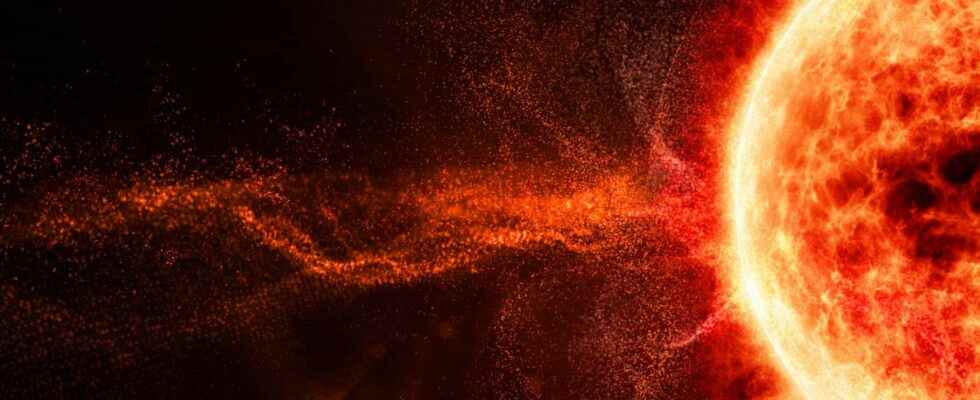Regularly, extremely violent eruptions occur on the surface of our Sun. A flash of light accompanied by the ejection of particles at speeds close to that of light. And researchers have finally located the place where these particles are accelerated.
You will also be interested
[EN VIDÉO] A giant solar flare unlike any we’ve ever seen This Tuesday, February 15, 2022, the space telescope named Extreme Ultraviolet Imager (EUI) on board the Solar Orbiter (ESA, NASA) recorded a giant solar flare. He was able, for the first time, to capture on the same image, the complete solar disk and the cloud of plasma ejected by the eruption up to 3.5 million kilometers in altitude. © ESA
The solar flares are extremely violent. They release, all at once, the equivalent of a hundred billion atomic bombs. But for a long time the physicists have struggled to understand how they manage to launch particles towards our Earth at speeds close to that of light. Until today and these works of a New Jersey Institute of Technology team (NJIT, USA).
By analyzing a powerful solar flare that occurred in 2017 – an X-class flare – researchers were able to pinpoint the precise location where charged particles are accelerating. Just at the tip of the brightest point of the eruption. In a region that astronomers call the cusp region.
Researchers from the New Jersey Institute of Technology (NJIT, USA) show how effective a solar flare is as an accelerator of particles. On the right, the extreme ultraviolet flare (yellow) and the location where most of the accelerated electrons were detected (blue). On the left, the distributions of thermal (red) and accelerated (blue) electrons. Almost all of the electrons in the cusp region above the flared arch (white outlines) were accelerated to many times their original thermal energy. © NJIT, CSTR; NASA SDO, AIA
An incredibly efficient process
It was the images from the Owens Valley solar array (United States) that allowed the researchers to build a map of the plasma involved in the eruption and to follow its evolution, second by second. To discover that it is in the region of the cusp that the plasma is converted into electrons at high energy. A region all the same twice as big as our Earth. Much more than the models suggested. And the conversion is incredibly efficient. Effective… 100%!
New Nature paper by Fleishman et al unravels the efficient acceleration region for high-energy electrons in a large solar flare, using microwave imaging spectroscopy data taken by yours truly@NJIT @CSLANJIT #NSF_fundedhttps://t.co/jR35xy0AHm
— Expanded Owens Valley Solar Array (@EOVSANJIT) June 8, 2022
This work could be used for particle physicists, to study phenomena that they cannot reproduce on Earth. They could also help to qualify the possible impacts of the events of meteorology spatial. Further data will be needed to refine the results. In particular, studies on solar flares less powerful, but much more frequent.
Special offer: for Father’s Day, offer the best of Science!
Your father is a great science enthusiast and unusual discoveries? And if you offer him a superb scientific exploration in paper format? Benefit from -20% on the Mag Futura (special offer: €15 instead of 19 €): 220 pages to explore 4 scientific issues that will shape our future!
Mag Futura is:
- 4 major scientific questions for 2022, from the Earth to the Moon
- 220 pages, 60 experts: no fake news, just science
- Home delivery with electronic gift card
- An independent scientific media
Interested in what you just read?
